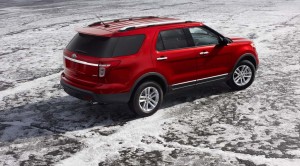
Bigger but lighter, the new Ford Explorer will get 25 mpg on the highway, according to new EPA testing.
The all-new Ford Explorer will get 25% better mileage than the outgoing SUV, according to new data released by the EPA, which oversees federal mileage testing.
Having switched from a truck-based platform to a car-like crossover design, the 2011 Explorer will get 17 miles per gallon in the city, 25 on the highway, with a combined rating of 20 mpg. The old model got 14/20 in front-drive configuration, 13/19 with an all-wheel-drive powertrain.
Fuel economy concerns were among the most significant of the “past reasons for turning away” from the Explorer and other SUVs, noted Derrick Kuzak, Ford’s global director of vehicle development.
With its new 3.5-liter V6 powertrain replacing the old Explorer’s 4.6-liter V8, Ford will be able to claim segment leadership on fuel economy. While the 2011 Toyota 4Runner matches Explorer in-town, it gets only 23 mpg on the highway. The all-new, 2011 Jeep Grand Cherokee also got an EPA rating of 23 highway, but just 16 in the city.
“Today’s customers want no trade-offs, which is why we focused on fuel economy leadership,” product development vice president Frank Davis said at an Explorer preview, this week.
The challenge was to balance the advantages of a crossover against those that might be lost by moving away from a more traditional, truck-like SUV package. Explorer, Ford officials admit, loses a modest amount of off-road capabilities, but that’s something, they insist, that only the most rugged outdoorsman would notice – and those buyers typically didn’t come to Ford, anyway.
Towing capacity was reduced slightly, meanwhile, from 7,250 lbs to 5,000. But Ford is again betting that the difference won’t matter to the typical Explorer buyer.
If anything, says Amy Marentic, the program’s marketing chief, Ford believes it will attract crossover buyers who want more ute-like capabilities. Several years ago, CUVs over-took traditional sport-utility vehicles in market demand – one key reason Ford abandoned the body-on-frame design of the old Explorer.
Ford also hopes to spur demand by loading Explorer up with an array of new safety features, including rear-seat seatbelts that incorporate airbags in their webbing, and the new Corner Control system, which is designed to automatically slow the vehicle down if a driver enters a curve too aggressively.
A safety problem involving defective tires, a decade ago, precipitated the steady decline in demand for what was once one of America’s most popular products. In the 1990s, Explorer volume routinely topped 400,000 annually. So far this year, however, Ford has sold less than 51,000 of the outgoing model.
The maker won’t reveal its sales target for the 2011 Ford Explorer but hints it expects a significant rebirth for the nameplate.
